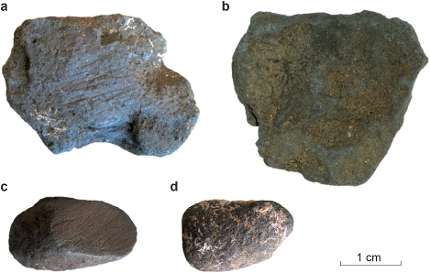Manganese dioxide blocs from Pech de l’Azé (France), both unmodified (b and d) and abraded (a and c).
Several Neanderthal sites in France have yielded large numbers of small black blocs. Neanderthals used these 'manganese oxides' in fire-making and not as previously thought for colouring.
The usual interpretation is that these 'manganese oxides' were collected for their colouring properties and used in body decoration, potentially for symbolic expression. Neanderthals habitually used fire and if they needed black material for decoration, soot and charcoal were readily available, whereas obtaining manganese oxides would have incurred considerably higher subsistence costs.
Combustion
A series of compositional analyses has led scientists from Leiden University and Delft University of Technology to infer that late Neanderthals at Pech-de-l'Azé I (Dordogne, SW France) were deliberately selecting manganese dioxide, 50,000 years ago. Statistically designed combustion experiments and thermo- gravimetric (TGA) measurements demonstrate that manganese dioxide reduces wood's auto-ignition temperature and substantially increases the rate of char combustion; in other words manganese dioxide facilitates fire making. (Youtube film showing the difference in combustion, lowering the ignition temperature from 350 to 250 degrees) Archaeological evidence for both fire places and the conversion of manganese dioxide blocs to powder supports the hypothesis that Neanderthals at Pech-de-l'Azé I used manganese dioxide in fire-making. Fire would have provided important subsistence benefits but its social and symbolic significance should not be overlooked.
Neanderthal cognitive capabilities
The selection and use of manganese dioxide for fire making is unknown from the ethnographic record of recent hunter gatherers. This knowledge had been lost. This unusual behaviour holds potential significance for our understanding of Neanderthal cognitive capabilities through the extent of their knowledge and insights. The actions involved in the preferential selection of a specific, non-combustible material and its use to make fire are not obvious nor intuitive. The knowledge and insights suggested by Neanderthal selection of manganese dioxide and use in fire-making are surprising and qualitatively different from the expertise commonly associated with Neanderthals.
Interestingly, whilst Neanderthals may have sourced and used manganese dioxide in fire making 50,000 years ago, manganese dioxide has important uses today in energy storage (batteries) and potentially in future clean energy production systems.
Manganese dioxide tolerated more freshly cut 'green' wood
Dr Peter Heyes, the first author of the paper, suggests: 'We don't know how Neanderthals made fire but given their skills with lithics, we might start with an assumption they used sparks and tinder. We don't bring it out particularly in the paper but manganese dioxide added to wood shavings or other tinder increases the efficiency with which the tinder captures a spark and lights. Starting a fire using sparks from flint without a metal striker is not as easy as it may seem but manganese dioxide has a significant beneficial effect.
Woodsmen typically keep a supply of naturally air-dried wood shavings or other tinder to help light fires. From the evidence of the wear patterns on their lithics, Neanderthals cut and whittled wood. If we assume Neanderthals could keep a supply of air-dried wood shavings, then once they had a small fire established aided by manganese dioxide, it could have been built with twigs and small braches. The growing fire would have tolerated more freshly cut 'green' wood.
Finding evidence to support a view on Neanderthal management of wood fuel resources is a very remote possibility. It could nevertheless have been an important aspect of subsistence. If Neanderthals could devote time and resources to collecting manganese dioxide for fire making, it is perhaps not unreasonable to assume they could manage wood fuel resources effectively.'
More information: Peter J. Heyes et al. Selection and Use of Manganese Dioxide by Neanderthals, Scientific Reports (2016). DOI: 10.1038/srep22159
Journal information: Scientific Reports
























